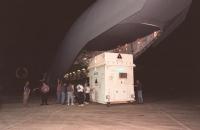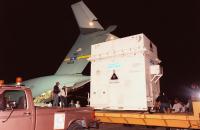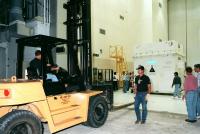
Kennedy Space Center News Release September 11, 1998 KSC Contact: George H. Diller KSC Release No. 100-98
MARS CLIMATE ORBITER ARRIVES AT KENNEDY SPACE CENTER TO BEGIN LAUNCH PREPARATIONSNASA's Mars Climate Orbiter arrived at Kennedy Space Center today to begin final preparations for launch. The spacecraft arrived aboard an Air Force C-17 cargo plane at the Shuttle Landing Facility early this morning following its flight from the Lockheed Martin Astronautics plant in Denver, Colo. The launch of the Mars Climate Orbiter is scheduled to occur aboard a Boeing Delta II (7425) rocket on Dec. 10, 1998.
When it first arrives at the red planet, the Mars Climate Orbiter will be used primarily to support its companion Mars Polar Lander spacecraft, planned for launch on Jan. 3, 1999. After that, the Mars Climate Orbiter's instruments will monitor the Martian atmosphere and image the planet's surface on a daily basis for one Martian year, the equivalent of two Earth years. During this time, the spacecraft will observe the appearance and movement of atmospheric dust and water vapor, as well as characterize seasonal changes on the surface. The detailed images of the surface features will provide important clues to the planet's early climate history and give scientists more information about possible liquid water reserves beneath the surface. The spacecraft is to be readied for launch in NASA's Spacecraft Assembly and Encapsulation Facility-2 (SAEF-2) located in the KSC Industrial Area. Among the processing activities to be performed in this clean room facility are a functional test of the science instruments and the basic spacecraft subsystems. Checks of the communications system will be performed including a verification of the spacecraft's ability to send data via the tracking stations of the Deep Space Network to the Jet Propulsion Laboratory (JPL) in Pasadena, Calif. and the Lockheed Martin plant in Denver, Colo. Following these checks, the spacecraft will be fueled with the spacecraft bipropellants of hydrazine and nitrogen tetroxide and mated to a Star 48 solid propellant upper stage booster. Finally, the combined spacecraft and upper stage elements will undergo spin balance testing. Meanwhile, at Launch Complex 17, the Delta II rocket will be undergoing erection and prelaunch checkout by Boeing on Pad A. The first stage is scheduled to be installed into the launcher on Oct. 29. Four solid rocket boosters will be attached around the base of the first stage on Nov. 2. The second stage will be mated atop the first stage on Nov. 4, and the fairing will be hoisted into the clean room of the pad's mobile service tower Nov. 6. The Mars Climate Orbiter with its upper stage booster will be transported to Complex 17 on Nov. 30 for hoisting atop the Delta and mating to the second stage. After the spacecraft undergoes a state of health check the next day, the two halves of the fairing will be placed around it on Dec. 3. Finally, there will be a mission dress rehearsal. At liftoff, the spacecraft will weigh 1,387 pounds (629 kilograms). It is 7.6 feet (2.3 meters) high, 6.4 feet (2 meters) deep, and 5.4 feet (1.6 meters) wide. Power is provided by a single large solar array which is 18.6 feet (5.7 meters) long and 6.8 feet (2 meters) across. After cruising in space for 286 days, the spacecraft will be captured in an elliptical orbit around Mars. The eight-day primary launch period to achieve an optimum cruise phase and Mars planetary encounter begins with an instantaneous launch window at 1:56 p.m. EST, Dec. 10. There are two instantaneous windows each day. A secondary six-day period of launch opportunity begins Dec. 18. The last day available for launch is Dec. 25. The 1998 Mars Climate Orbiter and Mars Polar Lander missions are managed by the Jet Propulsion Laboratory for NASA's Office of Space Science, Washington, D.C. JPL is a division of the California Institute of Technology, Pasadena, Calif. Lockheed Martin Astronautics, Denver, Colo. which built and operates the spacecraft, is JPL's industrial partner in the mission. |
| Home | Mars Polar Lander | Deep Space 2 Microprobes | Mars Climate Orbiter |
| Welcome | Mailing List | Links | Credits |
For questions or comments on this website please refer to our list of contacts.


